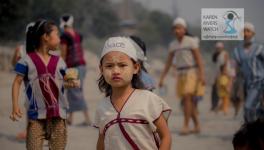Myanmar Military Armed to Teeth Despite Global Sanctions

Image Courtesy: Wikimedia Commons
In February 2021, Myanmar’s military seized power in a coup that plunged the country into a protracted crisis. Mass protests against the junta met a brutal crackdown and morphed into armed resistance with new groups, called People’s Defence Forces fighting the Army across swathes of rural Myanmar.
Some of the country’s ethnic armed organisations and older rebel forces that have battled the Army for decades, mostly from upland areas, have also thrown their weight behind the new resistance.
The Myanmar military’s scorched-earth tactics entail airstrikes and attacks that indiscriminately target civilians to punish dissent and cut off support for the resistance. Outside efforts to halt the fighting and force the military to cede power have mostly been left to the Association of Southeast Asian Nations (ASEAN) and have made no headway.
Against this backdrop, an authoritative report has claimed that the Myanmar military has imported, at least, $1 billion worth of arms, dual-use goods, equipment and raw materials to manufacture weapons since the coup.
The May 17 report, prepared by the UN Special Rapporteur on human rights in Myanmar, Tom Andrews, is titled ‘The Billion Dollar Death Trade: The International Arms Networks that Enable Human Rights Violations in Myanmar’.
Presented at the United Nations Human Rights Council’s 53rd Session, which began on June 19, the report has come out with details of how the junta acquired these weapons and materials and continues to acquire them despite global condemnation and international arms embargoes and sanctions.
The report shows how some UN member states have enabled these transfers, through either outright complicity or laxity in enforcing sanctions and bans on weapons and dual-use technology, to Myanmar. It also illustrates how sanctions fail to impact arms supplies to the junta, which continues to commit atrocities.
The detailed paper gives examples of how arms dealers and other entities linked to the junta easily circumvent sanctions by using existing front companies or creating new ones.
Ammunition and associated materials have been sent to Myanmar by five countries and/or entities based in member states, including India—the other countries named in the report are Russia, China, Thailand and Singapore.
A table after paragraph 46 of the report dealing with data by country and trade volume, however, clarifies that: “This Table indicates the location where (military) suppliers have a registered office and does not necessarily indicate the countries where manufacturing takes place…”
While there are detailed chapters about Russia, China and other countries, para 16 of the report reads: “Trade from India to the Myanmar military comes from both state-owned and private entities. State-owned arms manufacturers shipped a coastal surveillance system, a remote-controlled weapons system, unknown components from an ammunition and missile manufacturer, and 122 mm howitzer barrels. Private sector entities shipped explosive fuses likely for artillery shells.” The chapter on India also identifies several companies/entities.
In its Conclusions and Recommendations section, para 178 reads: “While Myanmar‘s brutal military junta is ultimately responsible for the crimes that are being inflicted on the people of Myanmar, they are facilitated by those who aid and abet the military by supplying the means to carry out their attacks. This report has laid out in detail the foreign state-owned enterprises—operating undoubtedly with their respective government‘s approval—and the private sector networks that are enabling the atrocities against the people of Myanmar.”
The report recommends several measures to stop foreign arms supplies to the junta by targeting its key sources of revenue, fully enforcing measures prohibiting the flow of arms to Myanmar and establishing and enforcing comprehensive sanctions on the arms networks procuring weapons for the Myanmar military.
“Seizing these options is imperative to protecting and defending the human rights of the people of Myanmar”, the report reads.
Earlier this month, the UN special envoy to Myanmar, Noeleen Heyzer, told the UN General Assembly (UNGA) that violence resulting from the brutal military coup was continuing in Myanmar on an “alarming scale”.
In its third year, “the impact of the military takeover on the country and its people has been devastating”, she added. Noting that the military had extended its state of emergency on February 1, she said it had intensified the use of force, including more aerial bombings, burning of civilian homes and other “grave human rights violations to maintain its grip on power”.
Atrocities, beheadings and the mutilation of rebel fighters’ bodies have been recorded together with escalating violence in ethnic areas. She said that despite the brutal repression, widespread and popular resistance continued by any means possible across much of Myanmar.
“A generation that benefited from Myanmar’s previous opening up, especially the youth, is now disillusioned, facing chronic hardship and many feeling they have no choice but to take up arms to fight the military rule,” Heyzer said.
She also called for sustainable solutions for the Rohingya people, telling the UNGA that it was critical that a Myanmar-led process reflective of all voices—especially women, youth and minorities—be allowed to decide the country’s future.
As the military junta tightens its stranglehold over Myanmar and its people and continues to strengthen itself, there seems to be a lack of cohesion and unity among the opposition parties.
As per a detailed report by the German broadcaster DW, various opposition groups in Myanmar agree only on one point: They reject the military regime and its concept of a “disciplined democracy”. Otherwise, these groups pursue their interests and deeply mistrust each other.
The DW report further says that no government has managed to unify the country in the past 75 years. Most recently, the coalition of the military and the National League for Democracy (NLD), led by Aung San Suu Kyi, also failed in this endeavour.
The attempt at power-sharing failed when the military seized power in the coup and arrested Suu Kyi and several other civilian leaders. The conflict and the resistance movement that ensued was the continuance of Myanmar’s bloody history.
Based on the roadmap, a shadow administration, the National Unity Government (NUG) was set up to lead the resistance movement. It also formed the People’s Defence Forces to wage an armed campaign against the military although many of these units are not under the NUG’s control.
However, it was clear from the beginning that not all opposition groups agreed with the process. Besides political differences, there were variances over areas these resistance groups would operate in and control and the divisive issue of the ethnicity of the local tribes and castes.
Besides, Myanmar lacks a charismatic leader like Suu Kyi—under house arrest—who can unify the country at this critical juncture. Considering the situation, it would be a bloody and treacherous path of struggle for Myanmar’s people to establish true democracy in their war-torn country.
The writer has extensively covered internal security, defence and civil aviation for the Press Trust of India for three decades. Views are personal.
Get the latest reports & analysis with people's perspective on Protests, movements & deep analytical videos, discussions of the current affairs in your Telegram app. Subscribe to NewsClick's Telegram channel & get Real-Time updates on stories, as they get published on our website.
























